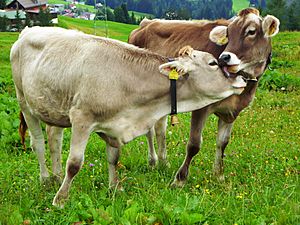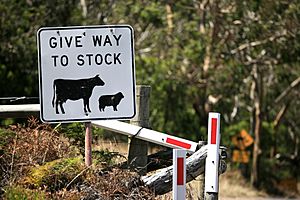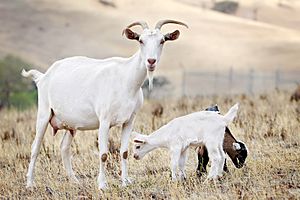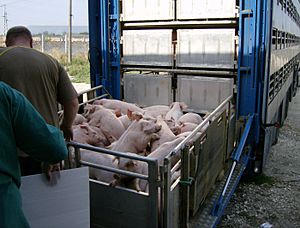Livestock facts for kids
Livestock are tamed animals that people keep for many reasons. They provide us with food, milk, leather, or wool. Some common types of livestock include cattle (cows and bulls), pigs, sheep, goats, and chickens. Chickens give us eggs, pigs give us ham, and cows give us milk and leather. Sheep provide wool for clothing.
In recent times, some groups also raise livestock to help save rare animal breeds from disappearing. The way we raise, care for, and use these animals is called animal husbandry. This practice is a big part of modern agriculture. People have been doing this for a very long time, ever since humans started farming instead of just hunting and gathering.
How people raise animals has changed a lot over time. Long ago, livestock roamed freely without fences. But now, most animals are raised in what is called intensive animal farming, or "factory farming." Today, more than 99% of livestock live on these factory farms. This method helps produce more food and other products. However, it can also affect animal welfare and the environment. Still, raising livestock is very important for the economy and culture in many rural areas.
Contents
What Does the Word Livestock Mean?
The word livestock was first used around the years 1650 to 1660. It combines the words "live" and "stock." Sometimes, people used "cattle" and "livestock" to mean the same thing. But today, cattle usually means just domesticated cows and bulls. The word livestock now means a wider range of animals.
How Livestock Farming Started
Raising animals began when people started living in settled farming communities. Before that, humans were hunter-gatherers. Animals become "domesticated" when humans control how they live and breed. Over many years, the way these farm animals behave and grow has changed a lot. Many modern farm animals would find it hard to live in the wild on their own.
Here are some examples of when animals were first tamed:
- Dogs were tamed very early, about 15,000 years ago.
- Goats and sheep were tamed between 11,000 and 5,000 years ago in Southwest Asia.
- Pigs were tamed by 8,500 BC in the Near East and 6,000 BC in China.
- Horses were tamed around 4000 BC.
- Cattle have been tamed for about 10,500 years.
- Chickens and other poultry might have been tamed around 7000 BC.
Different Types of Livestock
The word "livestock" can mean different things. It can be used in a narrow or broad way. Generally, livestock means any animal that humans keep for a useful or business purpose. This can include domesticated animals, animals that are only partly tamed, or wild animals kept in captivity.
| Animal / Type | Tamed Status | Wild Relative | When First Kept | Where First Kept | Current Uses | Picture | Ref |
|---|---|---|---|---|---|---|---|
| Alpaca Mammal, herbivore |
domestic | Vicuña | Between 5000 BC and 4000 BC | Andes | Alpaca fiber, meat |  |
|
| Addax Mammal, herbivore |
domestic | Addax | 2500 BCE | Egypt | Meat, hides |  |
|
| Bali cattle Mammal, herbivore |
domestic | Banteng | Unknown | Southeast Asia, Bali | Meat, milk, draught |  |
|
| Bison Mammal, herbivore |
captive (see also Beefalo) | N/A | Late 19th century | North America | Meat, leather |  |
|
| Camel Mammal, herbivore |
domestic | Wild dromedary and Bactrian camel | Between 4000 BC and 1400 BC | Asia | Mount, pack animal, meat, milk, camel hair |  |
|
| Cattle Mammal, herbivore |
domestic | Aurochs | 6000 BC | Southwest Asia, South Asia, North Africa | Meat (beef, veal), milk, leather, draught | 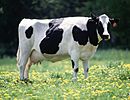 |
|
| Capybara Mammal, herbivore |
captive | Capybara | Unknown | South America | Meat, skins, pet |  |
|
| Collared peccary Mammal, omnivore |
captive | Collared peccary | Unknown | Brazil | Meat, tusks, skins, pet |  |
|
| Deer Mammal, herbivore |
captive | N/A | First century AD | UK | Meat (venison), leather, antlers, antler velvet |  |
|
| Donkey Mammal, herbivore |
domestic | African wild ass | 4000 BC | Egypt | Mount, pack animal, draught, meat, milk |  |
|
| Eland Mammal, herbivore |
domestic | Common eland, Giant eland | Unknown | South Africa, Kenya, Zimbabwe, West Africa | Meat, milk, leather, hides, horns |  |
|
| Elk Mammal, herbivore |
captive | Elk | 1990s | North America | Meat, antlers, leather, hides | 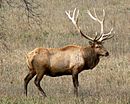 |
|
| Fallow deer Mammal, herbivore |
semidomestic | Fallow deer | 9th century BC | Mediterranean Basin | Meat, antlers, hides, ornamentation |  |
|
| Gayal Mammal, herbivore |
domestic | Gaur | Unknown | Southeast Asia | Meat, draught |  |
|
| Goat Mammal, herbivore |
domestic | Wild goat | 8000 BC | Southwest Asia | Milk, meat, wool, leather, light draught |  |
|
| Guinea pig Mammal, herbivore |
domestic | Cavia tschudii | 5000 BC | South America | Meat, pet |  |
|
| Greater cane rat Mammal, herbivore |
captive | Greater cane rat | Unknown | West Africa | Meat |  |
|
| Greater kudu Mammal, herbivore |
captive | Greater kudu | Unknown | South Africa | Meat, hides, horns, leather, pet |  |
|
| Horse Mammal, herbivore |
domestic | Wild horse | 4000 BC | Eurasian Steppes | Mount, draught, milk, meat, pet, pack animal |  |
|
| Llama Mammal, herbivore |
domestic | Guanaco | 3500 BC | Andes | Pack animal, draught, meat, fiber |  |
|
| Mule Mammal, herbivore |
domestic | Sterile Hybrid offspring of Jack donkey x mare (female horse) | Mount, pack animal, draught |  |
|||
| Moose Mammal, herbivore |
domestic | Moose | 1940s | Russia, Sweden, Finland, Alaska | Meat, milk, antlers, research, draft |  |
|
| Muskox Mammal, herbivore |
domestic | Muskox | 1960s | Alaska | Meat, wool, milk |  |
|
| Pig Mammal, omnivore |
domestic | Wild boar | 7000 BC | Eastern Anatolia | Meat (pork), leather, pet, mount, research |  |
|
| Rabbit Mammal, herbivore |
domestic | Wild rabbit | AD 400-900 | France | Meat, fur, leather, pet, research |  |
|
| Reindeer Mammal, herbivore |
semidomestic | Reindeer | 3000 BC | Northern Russia | Meat, leather, antlers, milk, draught |  |
|
| Sika deer Mammal, herbivore |
domestic | Sika deer | Unknown | Japan, China | Meat, antlers, hides, leather, pet, tourism |  |
|
| Scimitar oryx Mammal, herbivore |
domestic | Scimitar oryx | 2320-2150 BC | Egypt | Meat, sacrifice, horns, hides, leather |  |
|
| Sheep Mammal, herbivore |
domestic | Asiatic mouflon sheep | Between 11000 and 9000 BC | Southwest Asia | Wool, milk, leather, meat (lamb and mutton) |  |
|
| Thorold's deer Mammal, herbivore |
captive | Thorold's deer | Unknown | China | Meat, antlers |  |
|
| White-tailed deer Mammal, herbivore |
captive | White-tailed deer | Unknown | West Virginia, Florida, Colombia | Meat, antlers, hides, pet |  |
|
| Water buffalo Mammal, herbivore |
domestic | Wild Asian water buffalo (Arni) | 4000 BC | South Asia | Mount, draught, meat, milk |  |
|
| Yak Mammal, herbivore |
domestic | Wild yak | 2500 BC | Tibet, Nepal | Meat, milk, fiber, mount, pack animal, draught | 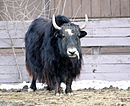 |
|
| Zebu Mammal, herbivore |
domestic | Aurochs | 8000 BC | India | Meat, milk, draught, hides |  |
How Farmers Raise Livestock
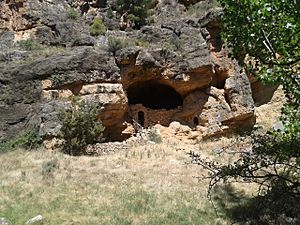
Raising animals, also known as animal husbandry, used to be a way for farmers to get everything their family needed. This included food, fuel, fertilizer, clothes, and even help with transport and farm work. Killing the animal for food was not always the main goal. Farmers would often collect products like wool, eggs, milk, and even blood (like the Maasai do) while the animal was still alive.
In a traditional system called transhumance, people and their animals would move between different pastures depending on the season. For example, in mountain areas, they would go to high pastures in summer and lower valleys in winter.
Animals can be kept in two main ways: extensively or intensively.
- Extensive systems mean animals roam freely or are watched by a herdsman. This often protects them from predators. For example, in the Western United States, large groups of cattle graze over huge areas of land. Similar systems are used for sheep, deer, ostrich, emu, llama, and alpaca. In some rural places, pigs and poultry (like chickens) can find much of their own food.
- Intensive systems mean animals are managed very closely. Dairy cows might stay in barns all the time, with food brought to them. Beef cattle might live in crowded feedlots. Pigs might live indoors in special buildings with controlled temperatures. Chickens might be kept in barns or cages for laying eggs.
Between these two ways are semi-intensive farms. These are often family-run farms where animals graze outside for most of the year. Farmers might make hay or silage (stored feed) for when grass doesn't grow. They also buy fertilizer, feed, and other things for the farm.
Protecting Livestock from Predators
Livestock farmers sometimes face problems from wild animals that hunt their livestock. They also have to deal with theft by rustlers.
- In North America, animals like the gray wolf, grizzly bear, cougar, and coyote can be a threat to livestock.
- In Europe, Asia, and Africa, predators include the wolf, leopard, tiger, lion, dhole, Asiatic black bear, crocodile, and spotted hyena.
- In South America, feral dogs, jaguar, anacondas, and spectacled bears can harm livestock.
- In Australia, the dingo, fox, and wedge-tailed eagle are common predators. Sometimes, even domestic dogs can kill livestock if their hunting instinct takes over.
Moving and Selling Livestock
Many livestock animals are herd animals, meaning they like to stay in groups. In the past, they were often driven to market "on the hoof" (walking) to a town or central place. This method is still used in some parts of the world today.
Now, in many developed countries, trucks are commonly used to transport animals. Local and regional livestock auctions and commodity markets are places where people buy and sell livestock. In other areas, animals might be bought and sold in a bazaar, like in many parts of Central Asia.
In developing countries, making it easier for farmers to sell their livestock has encouraged them to invest more in their animals. This has helped improve their lives. At stock shows, farmers bring their best livestock to compete with other farmers.
Images for kids
See also
 In Spanish: Ganadería para niños
In Spanish: Ganadería para niños


